Belgian Fortifications, May 1940
Written by
Bernard Vanden Bloock
[
Overview |
Deep Defences |
Border Defences |
Conclusions
]
[
Appendix A: Bunker Types |
Appendix B: Weapons |
Bibliography
]
Appendix B: Weapons
Maxim 08 Heavy Machine Gun
|
Maxim 08 Technical Data
|
|
Country of Origin:
|
Germany
|
|
Manufacturer:
|
Spandau Arsenal, Deutsche Waffen und Munitions Fabrike,
Berlin
|
|
Role:
|
Heavy machine gun
|
|
Calibre/cartridge
|
7.92 mm
|
|
Type of feed
|
250 round belt
|
|
Weight
|
26, 54 kg + 31,98 kg for mounting
|
|
Overall length
|
1,175 mm
|
|
Length of barrel
|
28.35 in
|
|
Muzzle velocity
|
892 m/sec (ft/sec)
|
|
Rate of fire (cyclic)
|
Practical: 100 rpm / Theoretical: 450 rpm
|
|
Effective range
|
650 m (maximum range: 3,000 m)
|
The Maxim 08 machine gun was Belgium’s standard
machine gun for the infantry. Twelve of the 18 infantry divisions were
equipped with Maxims. Six second-reserve infantry divisions were armed
with the Colt machine gun. The two cavalry divisions and the two Chasseurs
ardennais divisions used the Hotchkiss. Most of the Maxims in Belgian
service were leftovers from World War I handed over by Germany after the
armistice. The Maxim was a good, reliable weapon, but heavy and unwieldy.
The machine gun bunkers in the various fortified
positions were not garrisoned on a permanent base and remained unarmed
until occupied by an infantry unit, which would install its Maxims in
the firing ports. To this end, firing ports were equipped with a special
fixture, called dispositif Chardome, which allowed the machine
gun crew to quickly place their gun in a stable firing position. Basically,
the crew first folded the Maxim’s sled-like bipod, and then put the gun
to rest on the Chardome mount.
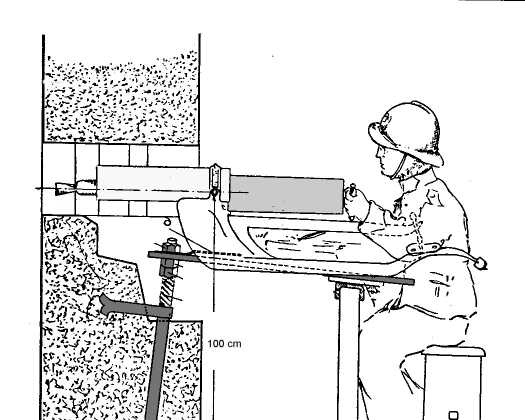
A drawing of the ‘Chardome’ Machine gun mount.
|
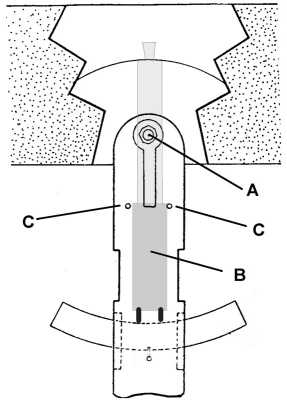
Top-down view of the ‘Chardome’, showing the plate on which the Maxium
was rested. A - a threaded pivot to which the gun’s sled is fastened.
B - the machine gun itself. The two holes in C were used with the
08/15 version of the Maxim, which was fitted with a bipod.
|
The Chardome’s drawback was that it was specially
designed for the Maxim 08 and its light version, the 08/15. It could not
be used with any other weapon. This created problems in those instances
where the bunkers were occupied by Allied troops. On the KW line, for
instance, BEF infantry found they could not attach their Bren guns to
the fixtures. They were forced to dismantle the Chardome and build
a makeshift firing platform with sandbags before they could fire their
Bren guns from the bunker’s ports.
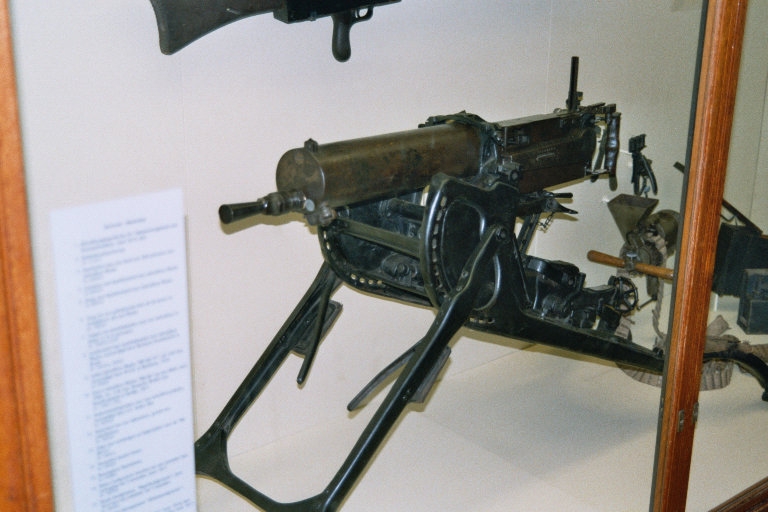
The Maxim 08 heavy machine gun. (Brussels Army Museum)
|
Maxim 08/15 Light Machine Gun
The Belgian forts, which were garrisoned permanently and
therefore had their own armament, used two types of automatic weapons:
the 08/15 ‘light’ variant of the Maxim placed in special fixed mounts
and the Browning FM.30 automatic rifle. The former was used in a heavy
machine gun role to deny the approaches of the fort to enemy infantry;
the latter served as a light machine gun for close defence. Both weapons
will be described in more detail in the follow-up article on Belgian forts.
Fusil-mitrailleur 1930 (Fm 30) Browning Mod. 30 Light Machine
Gun

The FM 30 demonstrated
by His Majesty Leopold III, King of the Belgians.
|
|
Fusil-mitrailleur
1930 (Fm 30) Browning Technical Data
|
|
Country of Origin:
|
Belgium
|
|
Manufacturer:
|
Fabrique Nationale, Herstal (Belgium)
|
|
Role:
|
Light machine gun
|
|
Caliber/cartridge
|
7.65 mm
|
|
Type of feed
|
20 rounds clip
|
|
Weight
|
9,300 kg
|
|
Overall length
|
119.4 cm (47 in) |
|
Length of barrel
|
61.1 cm (24.07 in) |
|
Muzzle velocity
|
850 m/sec (2650 fps) |
|
Rate of fire (cyclic)
|
600 rpm or 350 rpm
|
|
Effective range
|
550 m
|
This weapon is a modified 1930 version of the famous
Browning Automatic Rifle in use in the US army in the first and second
world wars. Among other things, the Belgians changed the calibre to 7,65
mm, so the weapon could fire the Belgian standard 7,65 mm mod. 30 cartridge.
The “Belgian BAR” as it is sometimes called was the standard squad light
machine gun of the Belgian army. It was distributed in all units except
the six second reserve infantry divisions which used the Chauchat light
machine gun.
The FM mod. 30 was also widely used in forts and
bunkers where it was attached to a special fixed mount. More on this in
the follow-up article on the forts.
C 47 L/30 D - 47 mm Anti-Tank Gun
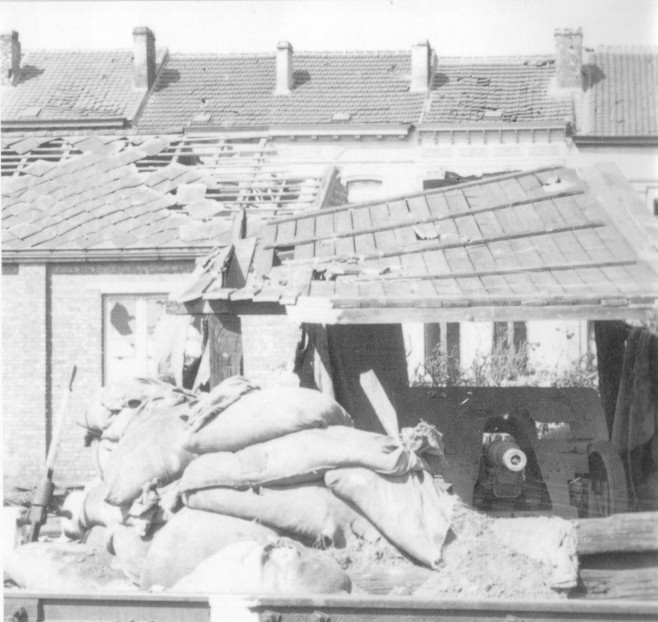
A towed C 47 in a firing
position near the Leuven train station. Leuven, defended by British
troops and some Belgian elements, saw heavy fighting on 14 May.
|
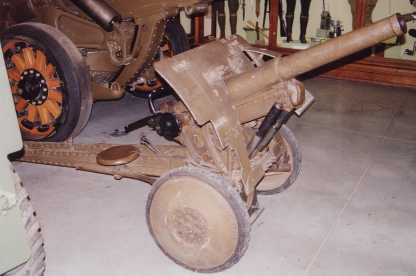
C47 at the Brussels Army Museum
|
|
C 47 L/30 D - 47 mm Anti-Tank Gun Technical Data
|
|
Country of Origin:
|
Belgium
|
|
Manufacturer:
|
Fonderie Royale de Canons, Herstal (Belgium)
|
|
Role:
|
Heavy anti-tank Cannon
|
|
Calibre
|
47 mm
|
|
Overall length
|
Unknown |
|
Length of barrel
|
1,435 m
|
|
Rate of fire (cyclic)
|
Unknown |
|
Traverse
|
20°L / 20° R (towed version) 8° L / 8° R (bunker mount)
20°L / 20° R (sphere mount)
|
|
Elevation
|
- 3° to +20°
|
|
Muzzle velocity
|
675 m/sec (AP) / 450 m/sec (HE)
|
|
Projectile weight
|
1,560 kg (AP) / 1,665 (HE)
|
|
Practical range
|
Unknown |
|
Effective range
|
2,000 m
|
The C 47 is the main anti tank gun in use in the Belgian
army in 1940. It was used in three different roles: towed anti tank gun
in the field army, fixed anti tank gun in bunkers and forts, and motorised
gun aboard the Belgian T-13 light tank destroyer. It was an effective
gun by all accounts, markedly superior to the German 37 mm gun, but perhaps
not as good as the French 47 mm.
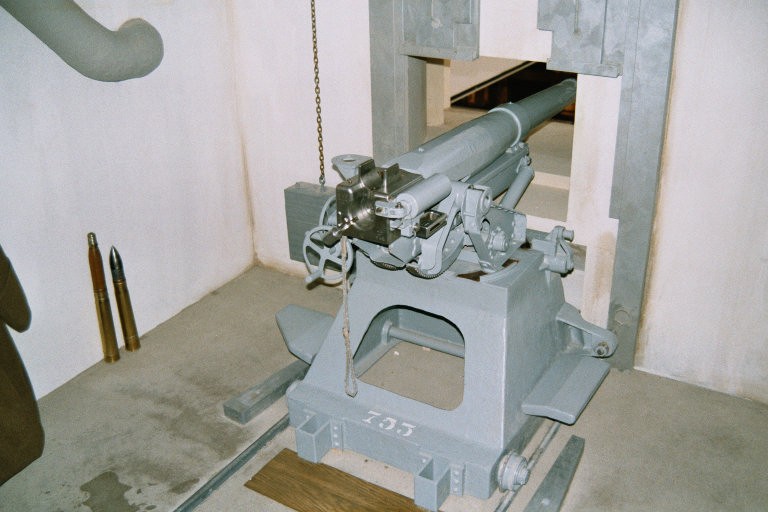
The C 47 gun fitted on its special bunker mount.
The chariot the gun is fitted to is mounted on rails to absorb the gun’s recoil, much like in the ships of the
18th century. What you see is a reconstructed bunker interior as shown at the Brussels army museum.
The gun and the chariot are vintage WWII material though ,with only the aiming system missing).
|
C 60 L/50 – 60 mm Anti-Tank Gun
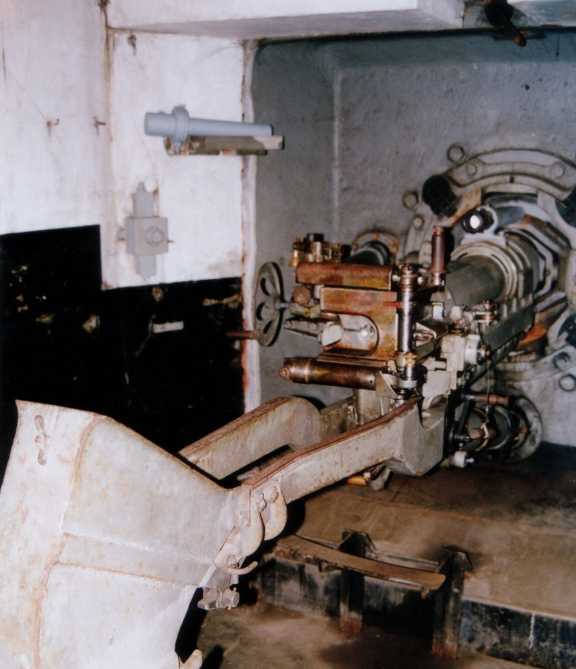
A C 60 interdicting one
of the anti tank moats of Fort Battice (PFL I). Spent casings were
automatically thrown into the bin on the left and evacuated to a
special chamber underneath the gun compartment.
|
|
C 60 L/50 - 60 mm Anti-Tank Gun Technical Data
|
|
Country of Origin:
|
Belgium
|
|
Manufacturer:
|
Fonderie Royale de Canons, Herstal (Belgium)
|
|
Role:
|
Fortress anti-tank Cannon
|
|
Calibre
|
60 mm
|
|
Overall length
|
Unknown |
|
Length of barrel
|
300 cm
|
|
Rate of fire (cyclic)
|
Unknown |
|
Traverse
|
20° L / 20* R (sphere mount)
|
|
Elevation
|
- 20° to +5° (sphere mount)
|
|
Muzzle velocity
|
900+ m/sec
|
|
Projectile weight
|
3,020 g (HE) or 3,600 (AP)
|
|
Effective range
|
3,000 m
|
The C 60 was used exclusively as a fixed anti tank
defence in some of the forts (Eben-Emael, Battice) and a few bunkers directly
attached to forts. There was no towed version of this weapon. Since none
of the forts were ever attacked by tanks, it is pretty certain that the
C 60 was never used in its primary role as an anti-tank weapon. It was
used extensively by the forts to fire HE ammunition. The gun was equipped
with a special aiming device for indirect fire.
According to veteran Maurice George, artillery
instructor at Fort Battice, the trajectory of a shell fired by the C 60
would drop just one mil after 1,000 m.
This article first appeared in World War II Online - Technical Publications.
Copyright 2005 Bernard Vanden Bloock
|
|